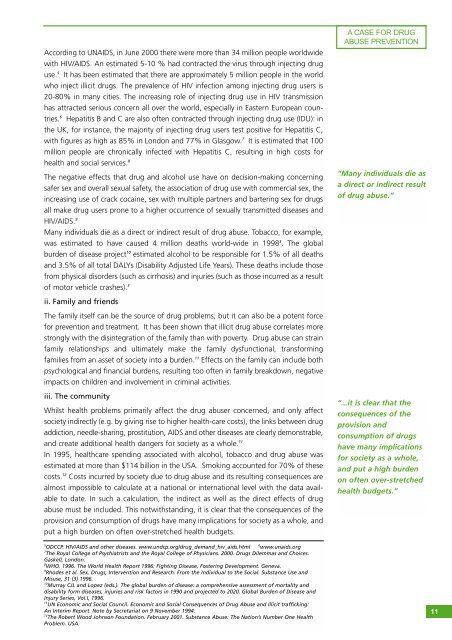PDF (Lessons learned in drug abuse prevention: a global review)
PDF (Lessons learned in drug abuse prevention: a global review)
PDF (Lessons learned in drug abuse prevention: a global review)
Create successful ePaper yourself
Turn your PDF publications into a flip-book with our unique Google optimized e-Paper software.
Accord<strong>in</strong>g to UNAIDS, <strong>in</strong> June 2000 there were more than 34 million people worldwide<br />
with HIV/AIDS. An estimated 5-10 % had contracted the virus through <strong>in</strong>ject<strong>in</strong>g <strong>drug</strong><br />
use. 5<br />
It has been estimated that there are approximately 5 million people <strong>in</strong> the world<br />
who <strong>in</strong>ject illicit <strong>drug</strong>s. The prevalence of HIV <strong>in</strong>fection among <strong>in</strong>ject<strong>in</strong>g <strong>drug</strong> users is<br />
20-80% <strong>in</strong> many cities. The <strong>in</strong>creas<strong>in</strong>g role of <strong>in</strong>ject<strong>in</strong>g <strong>drug</strong> use <strong>in</strong> HIV transmission<br />
has attracted serious concern all over the world, especially <strong>in</strong> Eastern European countries.<br />
6 Hepatitis B and C are also often contracted through <strong>in</strong>ject<strong>in</strong>g <strong>drug</strong> use (IDU): <strong>in</strong><br />
the UK, for <strong>in</strong>stance, the majority of <strong>in</strong>ject<strong>in</strong>g <strong>drug</strong> users test positive for Hepatitis C,<br />
with figures as high as 85% <strong>in</strong> London and 77% <strong>in</strong> Glasgow. 7 It is estimated that 100<br />
million people are chronically <strong>in</strong>fected with Hepatitis C, result<strong>in</strong>g <strong>in</strong> high costs for<br />
health and social services. 8<br />
The negative effects that <strong>drug</strong> and alcohol use have on decision-mak<strong>in</strong>g concern<strong>in</strong>g<br />
safer sex and overall sexual safety, the association of <strong>drug</strong> use with commercial sex, the<br />
<strong>in</strong>creas<strong>in</strong>g use of crack coca<strong>in</strong>e, sex with multiple partners and barter<strong>in</strong>g sex for <strong>drug</strong>s<br />
all make <strong>drug</strong> users prone to a higher occurrence of sexually transmitted diseases and<br />
HIV/AIDS. 9<br />
Many <strong>in</strong>dividuals die as a direct or <strong>in</strong>direct result of <strong>drug</strong> <strong>abuse</strong>. Tobacco, for example,<br />
was estimated to have caused 4 million deaths world-wide <strong>in</strong> 1998 3 . The <strong>global</strong><br />
burden of disease project 10 estimated alcohol to be responsible for 1.5% of all deaths<br />
and 3.5% of all total DALYs (Disability Adjusted Life Years). These deaths <strong>in</strong>clude those<br />
from physical disorders (such as cirrhosis) and <strong>in</strong>juries (such as those <strong>in</strong>curred as a result<br />
of motor vehicle crashes). 3<br />
ii. Family and friends<br />
The family itself can be the source of <strong>drug</strong> problems; but it can also be a potent force<br />
for <strong>prevention</strong> and treatment. It has been shown that illicit <strong>drug</strong> <strong>abuse</strong> correlates more<br />
strongly with the dis<strong>in</strong>tegration of the family than with poverty. Drug <strong>abuse</strong> can stra<strong>in</strong><br />
family relationships and ultimately make the family dysfunctional, transform<strong>in</strong>g<br />
families from an asset of society <strong>in</strong>to a burden. 11 Effects on the family can <strong>in</strong>clude both<br />
psychological and f<strong>in</strong>ancial burdens, result<strong>in</strong>g too often <strong>in</strong> family breakdown, negative<br />
impacts on children and <strong>in</strong>volvement <strong>in</strong> crim<strong>in</strong>al activities.<br />
iii. The community<br />
Whilst health problems primarily affect the <strong>drug</strong> <strong>abuse</strong>r concerned, and only affect<br />
society <strong>in</strong>directly (e.g. by giv<strong>in</strong>g rise to higher health-care costs), the l<strong>in</strong>ks between <strong>drug</strong><br />
addiction, needle-shar<strong>in</strong>g, prostitution, AIDS and other diseases are clearly demonstrable,<br />
and create additional health dangers for society as a whole. 11<br />
In 1995, healthcare spend<strong>in</strong>g associated with alcohol, tobacco and <strong>drug</strong> <strong>abuse</strong> was<br />
estimated at more than $114 billion <strong>in</strong> the USA. Smok<strong>in</strong>g accounted for 70% of these<br />
costs. 12 Costs <strong>in</strong>curred by society due to <strong>drug</strong> <strong>abuse</strong> and its result<strong>in</strong>g consequences are<br />
almost impossible to calculate at a national or <strong>in</strong>ternational level with the data available<br />
to date. In such a calculation, the <strong>in</strong>direct as well as the direct effects of <strong>drug</strong><br />
<strong>abuse</strong> must be <strong>in</strong>cluded. This notwithstand<strong>in</strong>g, it is clear that the consequences of the<br />
provision and consumption of <strong>drug</strong>s have many implications for society as a whole, and<br />
put a high burden on often over-stretched health budgets.<br />
A CASE FOR DRUG<br />
ABUSE PREVENTION<br />
“Many <strong>in</strong>dividuals die as<br />
a direct or <strong>in</strong>direct result<br />
of <strong>drug</strong> <strong>abuse</strong>.”<br />
“...it is clear that the<br />
consequences of the<br />
provision and<br />
consumption of <strong>drug</strong>s<br />
have many implications<br />
for society as a whole,<br />
and put a high burden<br />
on often over-stretched<br />
health budgets.”<br />
5 ODCCP. HIV/AIDS and other diseases. www.undcp.org/<strong>drug</strong>_demand_hiv_aids.html<br />
6 www.unaids.org<br />
7 The Royal College of Psychiatrists and the Royal College of Physicians. 2000. Drugs Dilemmas and Choices.<br />
Gaskell, London.<br />
8 WHO. 1996. The World Health Report 1996: Fight<strong>in</strong>g Disease, Foster<strong>in</strong>g Development. Geneva.<br />
9 Rhodes et al. Sex, Drugs, Intervention and Research: From the Individual to the Social. Substance Use and<br />
Misuse, 31 (3) 1996.<br />
10 Murray CJL and Lopez (eds.). The <strong>global</strong> burden of disease: a comprehensive assessment of mortality and<br />
disability form diseases, <strong>in</strong>juries and risk factors <strong>in</strong> 1990 and projected to 2020. Global Burden of Disease and<br />
Injury Series, Vol.I, 1996.<br />
11 UN Economic and Social Council. Economic and Social Consequences of Drug Abuse and Illicit traffick<strong>in</strong>g:<br />
An Interim Report. Note by Secretariat on 9 November 1994.<br />
12 The Robert Wood Johnson Foundation. February 2001. Substance Abuse: The Nation’s Number One Health<br />
Problem. USA.<br />
11
















